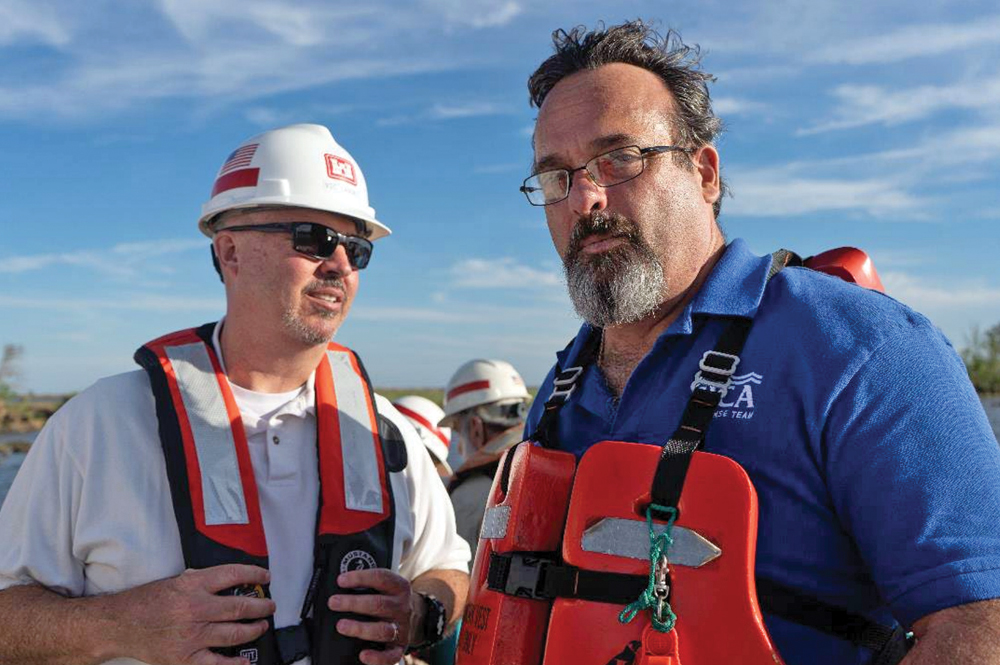Communication and partnerships. Gulf Intracoastal Waterway (GIWW) stakeholders would agree those are two words that have defined the Gulf Intracoastal Canal Association (GICA) for years. And in his two years as GICA president, Paul Dittman has carried that torch, communicating waterway issues to GICA members with lightning speed and partnering with local, state and federal partners through hurricanes and more to help ensure safe, reliable and efficient marine transportation throughout the Gulf Coast region.
The Waterways Journal interviewed Dittman ahead of GICA’s annual seminar to find out, in his words, what issues, challenges and opportunities are facing the waterway; what waterway stakeholders can anticipate for the future; and what continues to be GICA’s “secret sauce” for success.
WJ: The GIWW (especially in Louisiana) is an infrastructure-intense and dynamic waterway as it intersects with restoration projects, flood control features, smaller navigation canals, ports, dredging operations, movable bridges, etc. What are some positives in that regard? What challenges does that present?
Dittman: The GIWW in Louisiana is by far the most challenging portion of the canal to manage. The high concentration of U.S. Army Corps of Engineers lock infrastructure, coupled with the largest percentage of movable bridges of any state along the GIWW, increases the complexity and sensitivity of managing marine traffic on this waterway.
For example, in several locations, movable bridges, when unable to open to marine traffic, result in concurrent closures or severe restrictions at an adjacent lock, thus compounding delays by creating lock queues despite the lock being able to operate. The Black Bayou bridge in Calcasieu Parish, the Bayou Sorrel swing bridge in Iberville Parish and the movable bridges along the Inner Harbor Navigation Canal are just a few examples.
Close coordination and effective communication between GICA and a host of agencies, including the U.S. Army Corps of Engineers, U.S. Coast Guard, Louisiana Department of Transportation and Development, commercial railroads and various parish-level officials, is the critical success factor to effectively manage such a complex waterway and minimize supply chain impacts. Fostering and maintaining strong professional relationships and effective lines of communications with this extensive and diverse set of federal, state and local stakeholders is one of the most important, most challenging and most rewarding aspects of my role as GICA president.
WJ: The big news in early July was the allision at Algiers Lock. Vessels crossing the Mississippi River on the GIWW have to use the Inner Harbor Navigation Canal Lock (IHNC) on the east and Algiers, Harvey or the Bayou Sorrel-Port Allen route on the west. The average age of those five locks is 78.2 years. How critical are each of those locks, not only to the maritime industry, but to the nation as whole?
Dittman: The importance of these structures cannot be overstated as they facilitate the GIWW’s direct access to the Mississippi River system and our nation’s vast inland maritime transportation system. These structures provide the connective tissue linking the majority of our nation’s petrochemical industry with the rest of the nation. Any extended delays associated with these structures create significant supply chain impacts very quickly. GICA works diligently with all associated stakeholders to coordinate and manage routine and emergency maintenance closures at these structures and throughout the waterway to minimize navigation impacts and provide as much advance notice as possible for vessel routing and logistical planning purposes.
WJ: In the past, you’ve talked a lot about partnerships. How do those relationships and partnerships, forged during previous closures, hurricanes, etc., give you confidence going into the upcoming repair closure at Algiers Lock?
Dittman: My relationship with the GIWW managers at the USACE New Orleans District could not be any stronger. I received a call at 9:30 p.m. on the 4th of July directly from Vic Landry advising me of the situation at the Algiers Lock and the preliminary plan moving forward. This level of communication from Vic to me, and from me to Vic, is the norm, and I enjoy a similar relationship with the Galveston and Mobile districts. Within 20 minutes of completing the call with Vic, GICA sent a navigation alert membership-wide advising members of the issue, anticipated impacts and preliminary timelines for repair. I am confident this level of overt and effective communication and coordination between GICA and USACE will continue until repairs are completed.
WJ: For mariners on the GIWW, locks aren’t the only structures that have bearing on navigation. What are some other areas of concern along the waterway from an infrastructure standpoint?
Dittman: Movable bridges in Louisiana are a concern. Several of these bridges—in particular, the Black Bayou and Grand Lake bridges just east of Calcasieu Lock and the Bayou Sorrel swing bridge on the Port Allen-Morgan City Alternate Route—create a single point of failure if they are unable to operate. One of GICA’s primary concerns is the resiliency of these bridges and their ability to effectively support both maritime and shoreside evacuations in the event of a tropical weather event, and I’ve communicated these concerns to both the Louisiana Department of Transportation and Development and the U.S. Coast Guard. GICA values the strong relationship we have developed with LaDOTD senior leadership and the local district bridge engineers, and GICA greatly appreciates their dedicated efforts to maintain the operational effectiveness of movable bridges along the GIWW.
WJ: What about the coastal restoration and large-scale storm protection projects that intersect with the GIWW? How is GICA engaging with various agencies to support coastal resilience while also ensuring the waterway remains efficient and reliable for navigation?
Dittman: GICA is currently heavily involved with two storm protection projects, including a proposed sediment diversion project in the vicinity of the Bayou Boeuf Lock and the Morganza-to-the-Gulf project, which will include the installation of two gates across the GIWW in support of a storm surge barrier system. GICA fully supports coastal restoration and protection projects, because without them the future viability of the GIWW may be at serious risk.
However, we need to ensure the needs of the maritime industry are considered and addressed during the initial planning and coordination of any proposed projects. GICA is closely engaged with both the Louisiana Coastal Protection & Restoration Authority (CPRA) and the U.S. Army Corps of Engineers regarding the projects mentioned above, providing input regarding structure design and channel configuration considerations. Both projects will be highlighted and discussed during this year’s GICA Seminar. In addition, GICA reviewed CPRA’s Draft 2023 Master Plan and formally requested to participate in any future planning and discussion involving projects that may impact navigation along the GIWW and supporting waterways.
WJ: Is the news all gloom, doom and failing concrete? What are some positives on the horizon for the GIWW in terms of infrastructure?
Dittman: Not at all. We have seen major work completed recently at Calcasieu and Bayou Boeuf Locks, and there is ongoing significant work at Bayou Sorrel and Old River Locks to enhance the resiliency of these structures for years to come.
We are also seeing positive movement regarding the replacement of the Brazos River Flood Gates, the Inner Harbor Navigation Canal Lock in New Orleans and the Bayou Sorrel Lock. GICA membership is intimately involved assisting USACE with structure design and channel configuration considerations in support of the Inner Harbor Navigation Canal Lock and Brazos River Flood Gate projects, and both will be highlighted during this year’s GICA Seminar.
In addition, GICA has worked closely with Waterways Council Inc. and The American Waterways Operators to facilitate the funding needed to re-evaluate the benefit-to-cost ratio associated with Bayou Sorrel Lock, which is a critical preliminary step to initiating the lock’s eventual replacement.
WJ: So it really comes down to communication and relationships?
Dittman: Definitely. As I said during the annual hurricane planning meeting we had in May at the Port of New Orleans, it’s not just knowing who to call … it’s knowing who you’re calling. One of the most important facets of my job and role as GICA president is the facilitation and strengthening of these relationships, which are so critical to managing a 1,200-mile system as important and complex as the GIWW.



